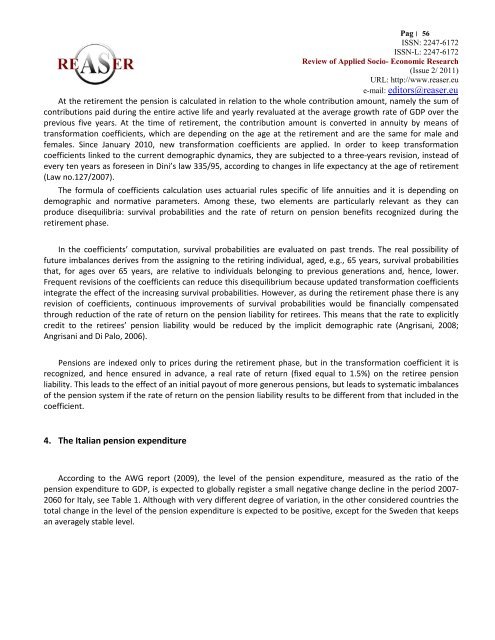Volume 2, ISSUE2/2011 - Review of Applied Socio-Economic ...
Volume 2, ISSUE2/2011 - Review of Applied Socio-Economic ...
Volume 2, ISSUE2/2011 - Review of Applied Socio-Economic ...
You also want an ePaper? Increase the reach of your titles
YUMPU automatically turns print PDFs into web optimized ePapers that Google loves.
Pag׀ 56 ISSN: 2247-6172ISSN-L: 2247-6172<strong>Review</strong> <strong>of</strong> <strong>Applied</strong> <strong>Socio</strong>- <strong>Economic</strong> Research(Issue 2/ <strong>2011</strong>)URL: http://www.reaser.eue-mail: editors@reaser.euAt the retirement the pension is calculated in relation to the whole contribution amount, namely the sum <strong>of</strong>contributions paid during the entire active life and yearly revaluated at the average growth rate <strong>of</strong> GDP over theprevious five years. At the time <strong>of</strong> retirement, the contribution amount is converted in annuity by means <strong>of</strong>transformation coefficients, which are depending on the age at the retirement and are the same for male andfemales. Since January 2010, new transformation coefficients are applied. In order to keep transformationcoefficients linked to the current demographic dynamics, they are subjected to a three-years revision, instead <strong>of</strong>every ten years as foreseen in Dini’s law 335/95, according to changes in life expectancy at the age <strong>of</strong> retirement(Law no.127/2007).The formula <strong>of</strong> coefficients calculation uses actuarial rules specific <strong>of</strong> life annuities and it is depending ondemographic and normative parameters. Among these, two elements are particularly relevant as they canproduce disequilibria: survival probabilities and the rate <strong>of</strong> return on pension benefits recognized during theretirement phase.In the coefficients’ computation, survival probabilities are evaluated on past trends. The real possibility <strong>of</strong>future imbalances derives from the assigning to the retiring individual, aged, e.g., 65 years, survival probabilitiesthat, for ages over 65 years, are relative to individuals belonging to previous generations and, hence, lower.Frequent revisions <strong>of</strong> the coefficients can reduce this disequilibrium because updated transformation coefficientsintegrate the effect <strong>of</strong> the increasing survival probabilities. However, as during the retirement phase there is anyrevision <strong>of</strong> coefficients, continuous improvements <strong>of</strong> survival probabilities would be financially compensatedthrough reduction <strong>of</strong> the rate <strong>of</strong> return on the pension liability for retirees. This means that the rate to explicitlycredit to the retirees’ pension liability would be reduced by the implicit demographic rate (Angrisani, 2008;Angrisani and Di Palo, 2006).Pensions are indexed only to prices during the retirement phase, but in the transformation coefficient it isrecognized, and hence ensured in advance, a real rate <strong>of</strong> return (fixed equal to 1.5%) on the retiree pensionliability. This leads to the effect <strong>of</strong> an initial payout <strong>of</strong> more generous pensions, but leads to systematic imbalances<strong>of</strong> the pension system if the rate <strong>of</strong> return on the pension liability results to be different from that included in thecoefficient.4. The Italian pension expenditureAccording to the AWG report (2009), the level <strong>of</strong> the pension expenditure, measured as the ratio <strong>of</strong> thepension expenditure to GDP, is expected to globally register a small negative change decline in the period 2007-2060 for Italy, see Table 1. Although with very different degree <strong>of</strong> variation, in the other considered countries thetotal change in the level <strong>of</strong> the pension expenditure is expected to be positive, except for the Sweden that keepsan averagely stable level.








